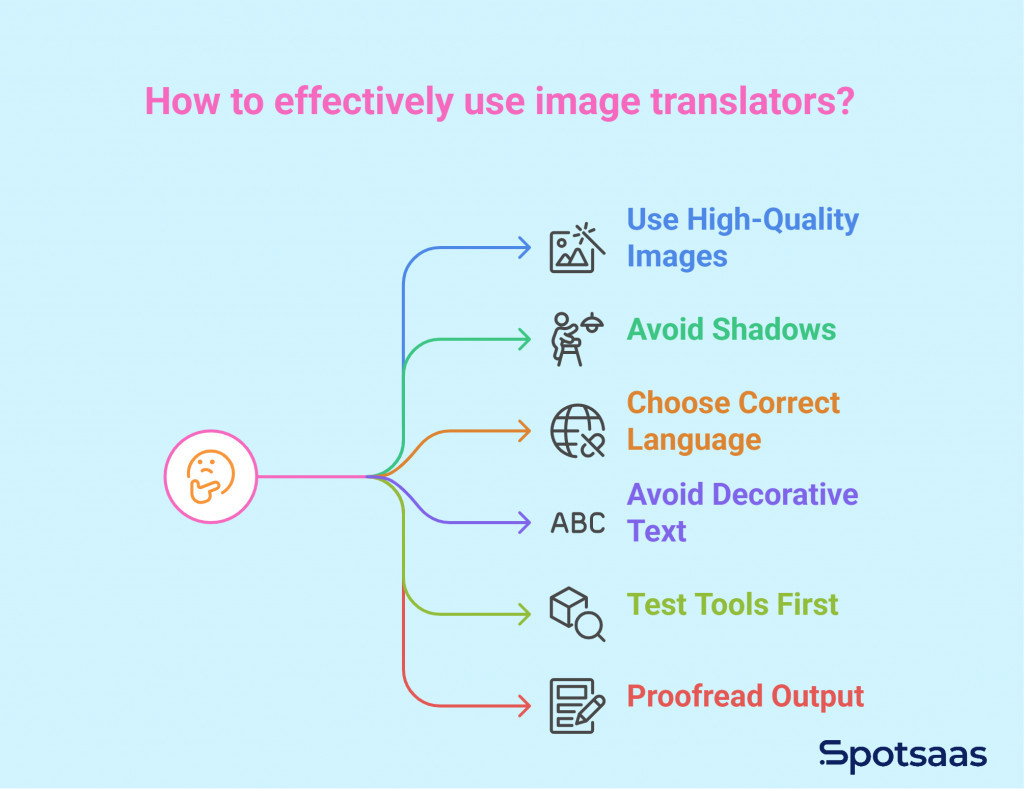Let’s say you have a paragraph in a different language, and you want to know what is written in it. What will you do? You will translate it into your native language using a text translation tool. But what if the paragraph is in a physical book or an image?
You cannot manually translate the text, as it would consume a lot of time. A simple solution would be to take an image and use the image translator tools. With these tools, you can translate text from photos in one language to another with a few clicks.
Key Takeaways
- Converts text in an image from one language to another.
- Anyone can use it, i.e., travelers, researchers, students, language learners, or professionals.
- Its fast processing can translate text in an image from one language to another in a few seconds.
- Image translators are easy to navigate. In a few clicks, you can translate text in images from one language to another.
- Accessible on smartphones, desktops, and the web for flexible, on-the-go use.
What is an Image Translator?
An image translator is a specialized tool that can translate text in images from one language to another. Its advanced OCR (optical character recognition) technology can scan text from images to generate accurate results.
Image translator is a perfect choice for people who frequently use or come in contact with images in different languages. The translators are the perfect solution for people who require quick answers to language problems. After all, manually finding the translation can be a headache.
General Process of Image Translators
Using the image translator tools is simple. Most of the tools use the same steps to translate image-based text. Given below is a step-by-step process through which image translators translate image-based texts.

1. Upload Image
The first step is to upload the image. If your text is in a physical book, use your smartphone to take an image. When you have the image of the text, simply upload the image to the translator tool. You can upload the image to the tool through
- Drag and drop whether the image is on the desktop or online.
- Upload the image from the file if the image is already on the desktop.
- Copy and paste if the image is from an online source.
2. Select the Languages
Once you have uploaded the images, the next step is to select the languages. There are usually two options for the languages.
First is the input language. In it, you define in what language your image is. If you do not know what language the text is in, you can still upload the text. The tools automatically detect language and translate the text in the image.
Second, the output language. It is an important part when translating the image-based text. In it, you describe the language in which you want the translated version of the image.
There are hundreds of languages available in which you can translate the image-based text.
3. Translate the Image
Once you have selected the languages, the next step is to translate the text. Click on the translate button to start the translation process. The translator analyzes the language of the input image and translates it into the language you selected for the output.
4. Download the Image
It is one thing to read the translated text from the image. However, if you want to save the image for later use, then you can download the image from the translator tool. The image translator tools offer an image download option for users after the conversion. Through it, the users can download the translated image from the tool.
Key Tips to Use the Image Translators
Given below are certain tips that you should focus on if you use an image translator:

1. Use a High-Quality Image
To accurately translate the text in the image, it is best if you use an image that is clear and focused. Blurry images can become a cause for error in the translation. Similarly, low-resolution images impact the accuracy and readability of the image translator tool. The reduced pixel may pose a problem for certain tools during conversion.
2. Avoid Shadows
The condition of the input image plays an important role in the accuracy of the output. Take the image in good lighting conditions. Avoid reflections or shadows that may make the text in the image look hazy or hidden.
3. Choosing the Correct Language
Since you are translating an image from one language to another, selecting the right language is important. Many tools would simply translate the images as long as the language is in their database. However, some tools require you to select the input language. If you do not select the right language, these tools will not translate the text in the image.
4. Avoid Decoration and Style in Text
For image translators, the plain and standard fonts are easier to scan and translate. Images with styles and colorful fonts may result in different errors, i.e., skipped text, blurry text, etc.
5. Test the Tools First
As there are various tools available online, it is in your best interest to test these tools first. Use small information chunks to test the working of the tools for accuracy. Through the testing, you will be able to identify the pros and cons of multiple tools. From there, you can identify the right tool for your use.
6. Proofread the Output
Although highly accurate in their processing, there are still chances of there being an error in the translated text. For this reason, reviewing the output is an important point. Through proofreading, you can identify if there is any error in the translation of the text in the image.
Takeaway
The image translators are not just some tools to translate images. They are your quick gateway to efficient work. Whether you want to understand information from different languages or save it, give the translators a try. No special skills or software are needed for it. In a few clicks, you can translate text in images from one language to another. So, go give it a try and make your work smoother and more efficient.





